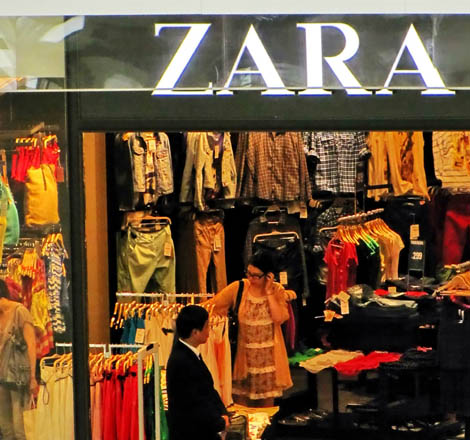The right line online for fashionistas
Updated: 2012-11-05 10:03
By He Wei in Shanghai (China Daily)
|
|||||||||||
Retailing companies test the waters in an Internet ocean of diversity
China's explosive e-commerce landscape is increasingly attracting fast-turnover foreign brands as they step up extending their footprints via online stores to capitalize on the fertile market.
For example, a drive to win new customers through the Internet with the latest fashion ranges helped Spain's Inditex SA, the owner of the Zara brand, to deliver an enviable first-half balance sheet in 2012.
Two weeks after the company rolled out the Zara online store for China on Sept 6, its interim report suggested a net profit rise by a third as market share gains largely offset the lower spending in its recession-hit home market.
With customers' disposable income being squeezed by soaring costs and severe austerity measures in Europe, Zara's move to tap into growth areas in emerging markets such as China has driven its bottom line upward, experts say.
"The drivers are certainly there - the rapid rollout of online sales and fast fashion - but even so it's a spectacular performance," said Societe Generale analyst Anne Critchlow in a research note.
Zara has been undertaking a big online push around the world since 2010, starting from its home country Spain and other European countries. Last year it launched e-commerce sites in the United States and Japan. Analysts estimate that it can add about 10 percent to a country's sales in the first year.
According to an e-mailed reply from Zara, its online inventory in China is designed to stay synchronized with the more than 100 brick-and-mortar stores across 40 cities.
Zara regards the physical and virtual stores to be highly "complementary", the statement said. "Customers are free to buy online and pick up at any store he or she regards convenient to drop by. They can ask any shop assistant to check whether certain sizes are in stock online."
Zara's hard-core competitor, Swedish brand H&M, is looking at the online arm of its business as the company celebrates the opening of its 100th outlet in Nanning, Guangxi Zhuang autonomous region.
Its chief executive officer Karl-Johan Persson told China Daily in September that China has in recent years been H&M's fastest-growing market in terms of number of outlets.
While the company has delayed the launch of Internet sales in the US for the second time as it grapples with the challenges of e-commerce, Persson was quoted by the Financial Times as saying that markets such as China would be next as the Swedish retailer looked to roll out both its website and mobile applications.
Different models
Zara and H&M, together with US retailer Gap Inc and Japanese brand Uniqlo, are often categorized as "fast-fashion" clothing because they sell on a weekly to monthly turnover affordable versions of new styles.
Apparently, brick-and-mortar stores alone are not enough to satisfy the demand of the massive young population that lives in third- and fourth-tier cities who long for international labels just as much as do their peers in Beijing and Shanghai.
As a result, foreign apparel has either gained ground in, or has had the potential, to exploit China's e-business over the past two years. However, each company has chosen different approaches.
Zara said it has hired a group of experts that monitors the global logistics system to ensure any order from China will be handled directly from its Spanish headquarters.
Unlike Zara, which operates the website entirely on its own, Uniqlo chose to outsource part of the business to third-party vendors.
Related Stories
E-commerce to be pillar of retail, top executives say 2012-11-02 11:22
360buy vs. Amazon duel for e-commerce 2012-10-24 13:55
Ministry vows to better guide development of e-commerce 2012-08-18 01:24
Discounting e-commerce firms win 'price war' in H1 2012-08-08 10:31
China's e-commerce employees to reach 2.65 million 2012-04-26 17:21
China's disabled enjoy e-commerce boom 2012-05-21 15:43
Today's Top News
President Xi confident in recovery from quake
H7N9 update: 104 cases, 21 deaths
Telecom workers restore links
Coal mine blast kills 18 in Jilin
Intl scholarship puts China on the map
More bird flu patients discharged
Gold loses sheen, but still a safe bet
US 'turns blind eye to human rights'
Hot Topics
Lunar probe , China growth forecasts, Emission rules get tougher, China seen through 'colored lens', International board,
Editor's Picks

|

|

|

|

|

|







